The Automotive Tensioner Market is estimated to be valued at USD 5.5 billion in 2025 and is projected to reach USD 9.0 billion by 2035, registering a compound annual growth rate (CAGR) of 5.1% over the forecast period.
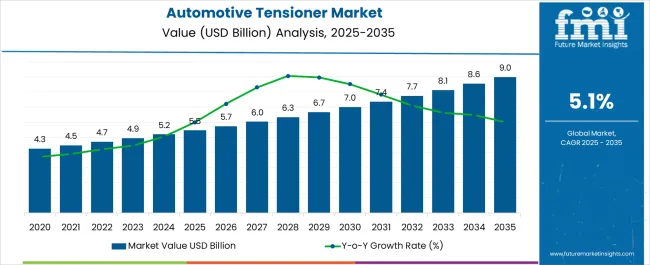
| Metric | Value |
|---|---|
| Automotive Tensioner Market Estimated Value in (2025 E) | USD 5.5 billion |
| Automotive Tensioner Market Forecast Value in (2035 F) | USD 9.0 billion |
| Forecast CAGR (2025 to 2035) | 5.1% |
The Automotive Tensioner market is experiencing steady growth driven by the increasing demand for efficient engine systems and rising adoption of advanced powertrain technologies. The market is influenced by trends such as lightweight vehicle components, enhanced fuel efficiency requirements, and the shift towards electric and hybrid vehicles, which require precise tension management in engine and accessory belts.
Growth is being supported by increasing automotive production in emerging markets and the replacement demand in mature markets where vehicles reach mid-life service cycles. Ongoing improvements in engine performance, combined with stricter emission regulations and growing consumer preference for reliable and low-maintenance components, are creating opportunities for market expansion.
The focus on durability, noise reduction, and smooth operation of timing belt systems has further encouraged OEMs and aftermarket players to integrate high-quality tensioners, enhancing both vehicle performance and longevity As automotive manufacturers continue to prioritize powertrain efficiency and maintenance cost reduction, the Automotive Tensioner market is expected to see sustained growth over the coming years.
The automotive tensioner market is segmented by type, sales channel, vehicle type, and geographic regions. By type, automotive tensioner market is divided into Timing Belt Automotive Tensioner, Timing Chain Automotive Tensioner, and Auxiliaries Drive Belt Automotive Tensioner. In terms of sales channel, automotive tensioner market is classified into OEMs and Aftermarket. Based on vehicle type, automotive tensioner market is segmented into Passenger Car (PC), 2-Wheeler, Commercial Vehicle, Light Commercial Vehicle (LCV), and Heavy Commercial Vehicle (HCV). Regionally, the automotive tensioner industry is classified into North America, Latin America, Western Europe, Eastern Europe, Balkan & Baltic Countries, Russia & Belarus, Central Asia, East Asia, South Asia & Pacific, and the Middle East & Africa.
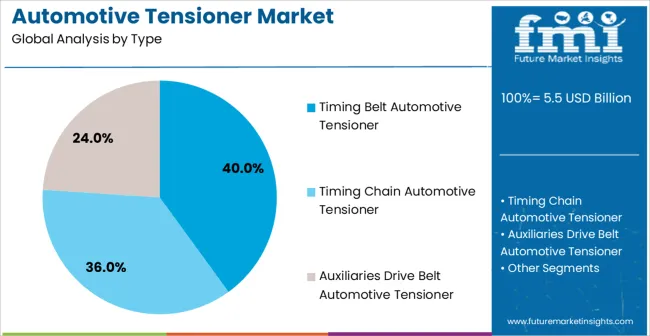
The Timing Belt Automotive Tensioner segment is projected to account for 40.00% of the overall Automotive Tensioner market in 2025, making it the leading type. Its dominance is being driven by its critical role in regulating engine timing and maintaining optimal belt tension, which directly impacts fuel efficiency and engine longevity.
The growth of this segment is being supported by widespread adoption in internal combustion engines across passenger vehicles, where precise timing ensures performance and reduces wear on engine components. Improvements in material quality and tensioner design, including automated adjustment mechanisms, have further reinforced the reliability and appeal of timing belt tensioners.
The preference for this segment is strengthened by OEM specifications and increasing consumer awareness of the importance of engine maintenance, which has accelerated replacement cycles in both new and existing vehicles As vehicles become increasingly sophisticated, the ability to provide durable, low-maintenance tensioner solutions is expected to sustain the market leadership of this segment.
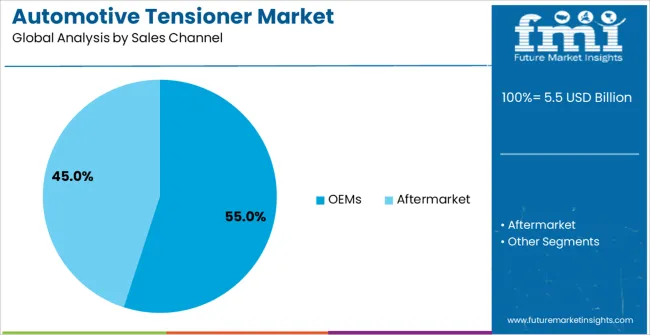
The OEMs sales channel segment is anticipated to hold 55.00% of the Automotive Tensioner market revenue in 2025, reflecting its dominant role in distribution. This prominence is being driven by automakers’ preference for sourcing high-quality, precision-engineered tensioners directly from original manufacturers to ensure compatibility with engine designs and maintain warranty standards.
OEM channels are favored for their reliability, adherence to technical specifications, and capacity to supply large-scale production requirements. The growth of this segment has been reinforced by expanding automotive production volumes globally and the increasing complexity of engine systems, which require direct integration of tensioners during assembly.
Additionally, OEM partnerships enable streamlined logistics, quality assurance, and traceability, which are critical in meeting regulatory and safety standards The continued focus on reducing engine failure risks and improving overall vehicle performance is expected to keep the OEMs channel as the primary contributor to market revenue in the near future.
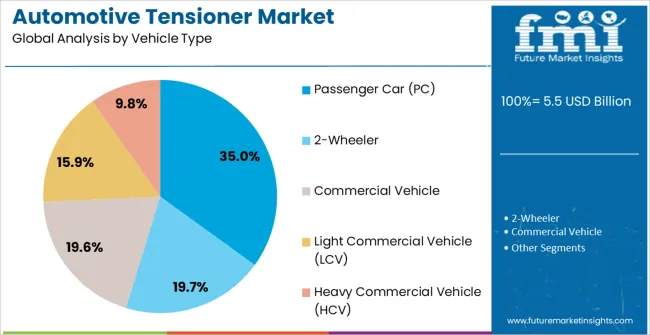
The Passenger Car vehicle type segment is expected to hold 35.00% of the Automotive Tensioner market in 2025, establishing it as the leading vehicle category. This prominence is being driven by the global expansion of passenger vehicle production and the increasing emphasis on fuel-efficient and low-maintenance engine components.
Passenger cars often rely on timing belt and accessory belt systems that demand reliable tensioners to optimize performance, reduce noise, and enhance durability. The growth of this segment is further supported by consumer expectations for vehicles with low operational costs and long service intervals, which reinforce demand for high-quality tensioners.
The segment’s dominance is also influenced by the widespread replacement cycles of belts and tensioners in passenger vehicles, which ensures consistent aftermarket demand As urbanization and mobility trends continue to expand, the passenger car segment is expected to remain the primary driver of Automotive Tensioner market growth, with opportunities for both OEM and aftermarket suppliers to innovate and capture additional value.
Automotive tensioner is a component that applies force to create tension on the belt or chain used in the automotive drive. It is widely used in automotive engines in order to reduce noise from the timing belt and to improve durability. Over the past few years, the need for engine downsizing and improved reliability have increased.
The trend includes shifting from belts to chains and the use of serpentine drives with single accessory drive belts. Moreover, increasing concern about global warming has lead the manufacturers to develop technologies that reduce fuel consumption.
Various types of automotive tensioners are available in the market including timing belt automotive tensioner, timing chain automotive tensioner, and auxiliaries drive belt automotive tensioner.
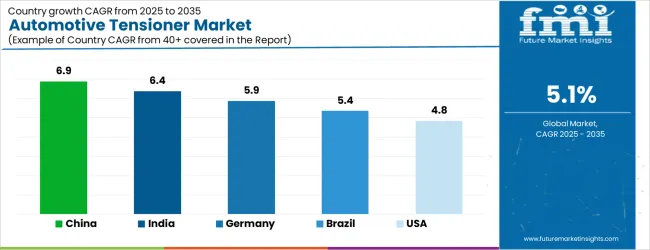
| Country | CAGR |
|---|---|
| China | 6.9% |
| India | 6.4% |
| Germany | 5.9% |
| Brazil | 5.4% |
| USA | 4.8% |
| UK | 4.3% |
| Japan | 3.8% |
The Automotive Tensioner Market is expected to register a CAGR of 5.1% during the forecast period, exhibiting varied country level momentum. China leads with the highest CAGR of 6.9%, followed by India at 6.4%. Developed markets such as Germany, France, and the UK continue to expand steadily, while the USA is likely to grow at consistent rates. Japan posts the lowest CAGR at 3.8%, yet still underscores a broadly positive trajectory for the global Automotive Tensioner Market. In 2024, Germany held a dominant revenue in the Western Europe market and is expected to grow with a CAGR of 5.9%. The USA Automotive Tensioner Market is estimated to be valued at USD 2.0 billion in 2025 and is anticipated to reach a valuation of USD 2.0 billion by 2035. Sales are projected to rise at a CAGR of 0.0% over the forecast period between 2025 and 2035. While Japan and South Korea markets are estimated to be valued at USD 277.6 million and USD 168.4 million respectively in 2025.
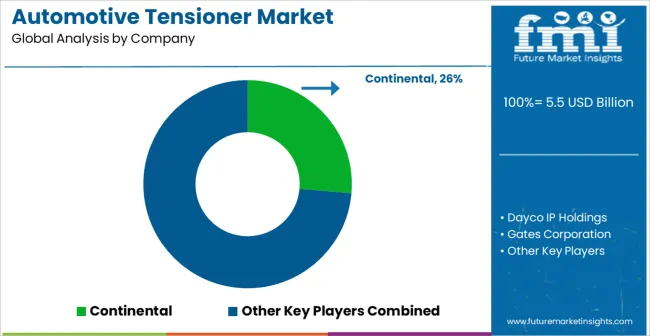
| Item | Value |
|---|---|
| Quantitative Units | USD 5.5 Billion |
| Type | Timing Belt Automotive Tensioner, Timing Chain Automotive Tensioner, and Auxiliaries Drive Belt Automotive Tensioner |
| Sales Channel | OEMs and Aftermarket |
| Vehicle Type | Passenger Car (PC), 2-Wheeler, Commercial Vehicle, Light Commercial Vehicle (LCV), and Heavy Commercial Vehicle (HCV) |
| Regions Covered | North America, Europe, Asia-Pacific, Latin America, Middle East & Africa |
| Country Covered | United States, Canada, Germany, France, United Kingdom, China, Japan, India, Brazil, South Africa |
| Key Companies Profiled | Continental, Dayco IP Holdings, Gates Corporation, Litens Automotive Group, NTN, Mubea, Tsubakimoto, KMC Automotive, Pricol Ltd, and Aba Automotive |
The global automotive tensioner market is estimated to be valued at USD 5.5 billion in 2025.
The market size for the automotive tensioner market is projected to reach USD 9.0 billion by 2035.
The automotive tensioner market is expected to grow at a 5.1% CAGR between 2025 and 2035.
The key product types in automotive tensioner market are timing belt automotive tensioner, timing chain automotive tensioner and auxiliaries drive belt automotive tensioner.
In terms of sales channel, oems segment to command 55.0% share in the automotive tensioner market in 2025.






Our Research Products

The "Full Research Suite" delivers actionable market intel, deep dives on markets or technologies, so clients act faster, cut risk, and unlock growth.

The Leaderboard benchmarks and ranks top vendors, classifying them as Established Leaders, Leading Challengers, or Disruptors & Challengers.

Locates where complements amplify value and substitutes erode it, forecasting net impact by horizon

We deliver granular, decision-grade intel: market sizing, 5-year forecasts, pricing, adoption, usage, revenue, and operational KPIs—plus competitor tracking, regulation, and value chains—across 60 countries broadly.

Spot the shifts before they hit your P&L. We track inflection points, adoption curves, pricing moves, and ecosystem plays to show where demand is heading, why it is changing, and what to do next across high-growth markets and disruptive tech

Real-time reads of user behavior. We track shifting priorities, perceptions of today’s and next-gen services, and provider experience, then pace how fast tech moves from trial to adoption, blending buyer, consumer, and channel inputs with social signals (#WhySwitch, #UX).

Partner with our analyst team to build a custom report designed around your business priorities. From analysing market trends to assessing competitors or crafting bespoke datasets, we tailor insights to your needs.
Supplier Intelligence
Discovery & Profiling
Capacity & Footprint
Performance & Risk
Compliance & Governance
Commercial Readiness
Who Supplies Whom
Scorecards & Shortlists
Playbooks & Docs
Category Intelligence
Definition & Scope
Demand & Use Cases
Cost Drivers
Market Structure
Supply Chain Map
Trade & Policy
Operating Norms
Deliverables
Buyer Intelligence
Account Basics
Spend & Scope
Procurement Model
Vendor Requirements
Terms & Policies
Entry Strategy
Pain Points & Triggers
Outputs
Pricing Analysis
Benchmarks
Trends
Should-Cost
Indexation
Landed Cost
Commercial Terms
Deliverables
Brand Analysis
Positioning & Value Prop
Share & Presence
Customer Evidence
Go-to-Market
Digital & Reputation
Compliance & Trust
KPIs & Gaps
Outputs
Full Research Suite comprises of:
Market outlook & trends analysis
Interviews & case studies
Strategic recommendations
Vendor profiles & capabilities analysis
5-year forecasts
8 regions and 60+ country-level data splits
Market segment data splits
12 months of continuous data updates
DELIVERED AS:
PDF EXCEL ONLINE
Automotive Chain Tensioners Market
Automotive Direct Liquid Cooling IGBT Module Market Size and Share Forecast Outlook 2025 to 2035
Automotive Hoses and Assemblies Market Size and Share Forecast Outlook 2025 to 2035
Automotive Network Testing Market Size and Share Forecast Outlook 2025 to 2035
Automotive Performance Part Market Size and Share Forecast Outlook 2025 to 2035
Automotive Carbon Ceramic Brake Market Size and Share Forecast Outlook 2025 to 2035
Automotive Camshaft Market Size and Share Forecast Outlook 2025 to 2035
Automotive Stamping Industry Analysis in India Size and Share Forecast Outlook 2025 to 2035
Automotive Cylinder Liner Market Size and Share Forecast Outlook 2025 to 2035
Automotive Microcontroller Market Size and Share Forecast Outlook 2025 to 2035
Automotive Roof Rails Market Size and Share Forecast Outlook 2025 to 2035
Automotive Active Safety System Market Size and Share Forecast Outlook 2025 to 2035
Automotive Diagnostic Scan Tool Market Size and Share Forecast Outlook 2025 to 2035
Automotive Test Equipment Market Size and Share Forecast Outlook 2025 to 2035
Automotive Dynamic Map Data Market Size and Share Forecast Outlook 2025 to 2035
Automotive Green Tires Market Size and Share Forecast Outlook 2025 to 2035
Automotive E-Tailing Market Size and Share Forecast Outlook 2025 to 2035
Automotive Interior Market Forecast Outlook 2025 to 2035
Automotive Key Market Size and Share Forecast Outlook 2025 to 2035
Automotive Appearance Chemical Market Forecast and Outlook 2025 to 2035

Thank you!
You will receive an email from our Business Development Manager. Please be sure to check your SPAM/JUNK folder too.
Chat With
MaRIA